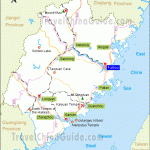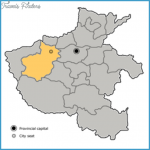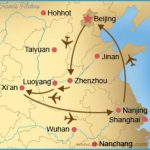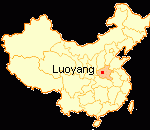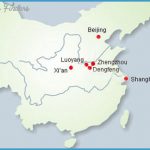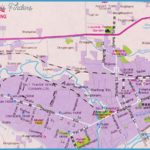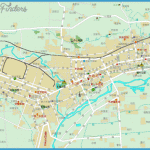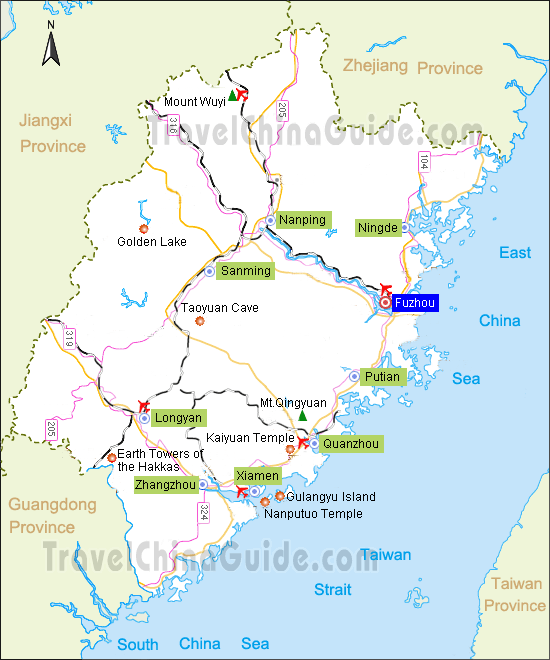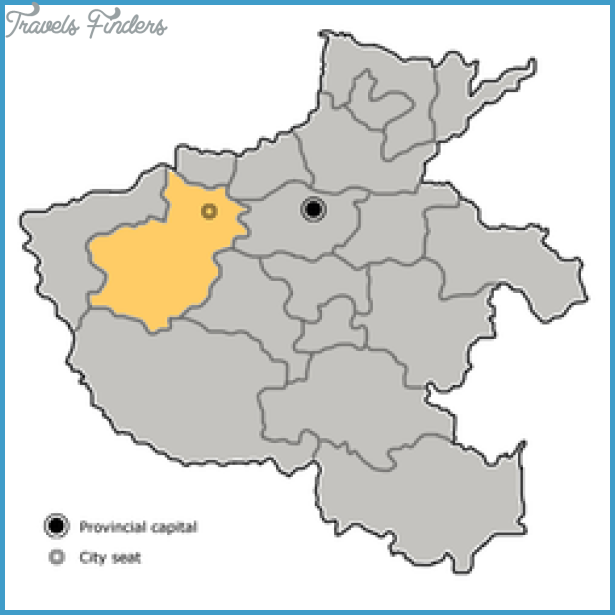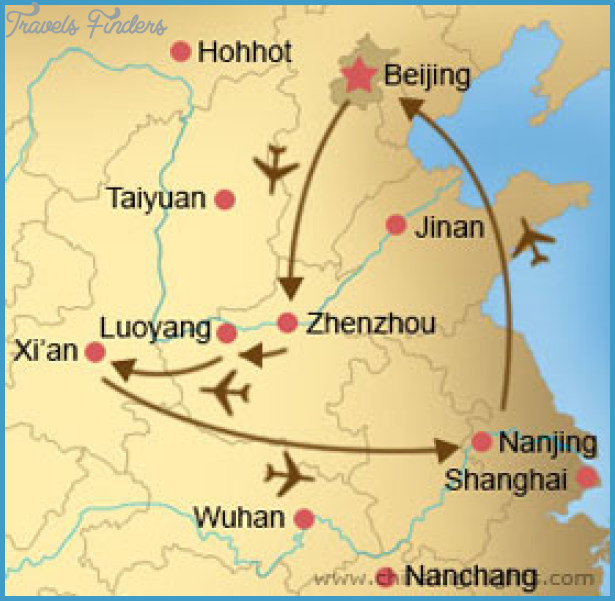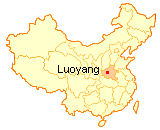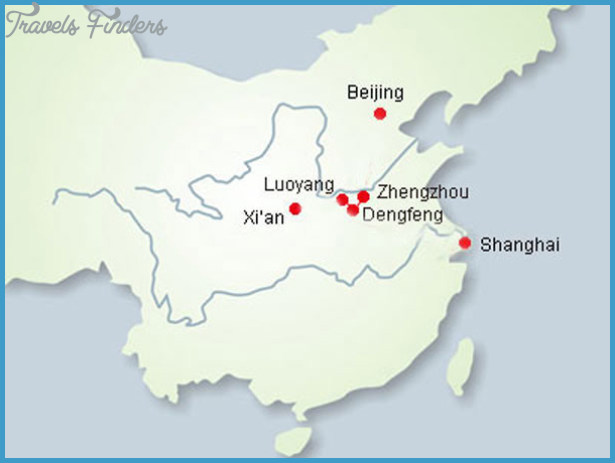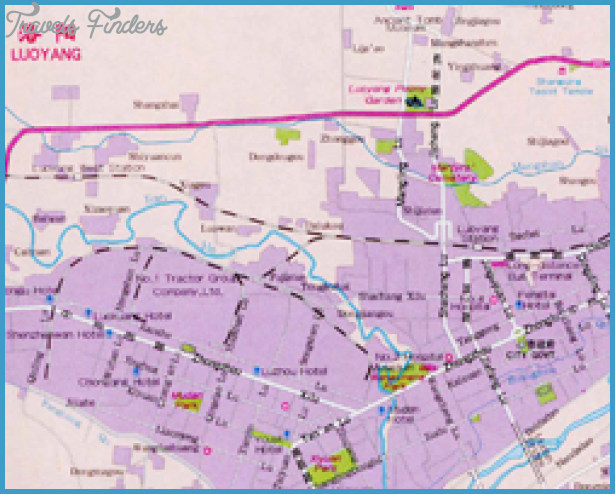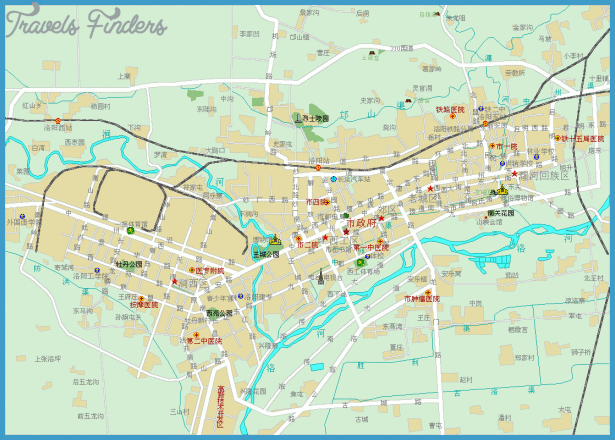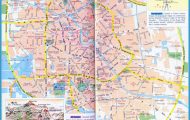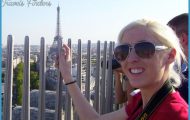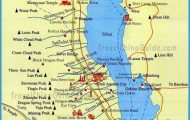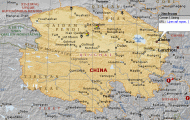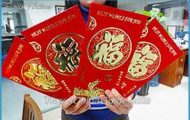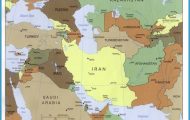Province: Henan. Area: 544sq.km/21 Osq. miles Population: 582,000 (conurbation 978,000)
Situation and Luoyang is situated at 112°27’E and 34°41’N, in the west ofthe province of
Communications Hena, on the River Luohe. Its name means “north of the Luo”.
The city is connected by rail with Beijing, Shanghai, Canton, Xi’an and Zhengzhou, while a small airport makes flights possible to Canton, Shanghai, Xi’an and Urumqi.
History Finds from the area show that settlements existed here even in Neolithic
times (Yangshaoand Longshan civilisation). Luoyang wasfrom770b.c. the capital of nine dynasties – firstly the Eastern Zhou dynasty (770-221 b.c.) under the name Wangcheng – and was therefore the military, economic and cultural centre ofthe country.
During the period of the Eastern Han dynasty (25-220), who likewise resided here, a large imperial academy was founded with some 30,000 students and a huge library was built. This period coincided with the invention of paper by Cai Lun and the advent of Buddhism. In a.d. 68 the White Horse Temple, the oldest Buddhist monastery in China, was built.
During the era of the Three Empires Luoyang was the capital of the Wei empire and subsequently ofthe Western Jin dynasty (265-316). The rulers ofthe Northern Wei dynasty (386-534), who also had their residence here, were great patrons of Buddhism and during this time more than 1000
To Longmen Grottoes 7 km
To Baima Temple 9 km temples were established. At the end of this period Luoyang was destroyed and rebuilt under the Sui (581-616).
In the Tang period (618-907) the city was the eastern capital alongside Chang’an. Since this time Luoyang has been known as the City of Peonies, reputedly a symbol of wealth.
The famous poets Du Fu and Li Bai lived and worked here. Empress Wu Zetian (reigned 690-705) had a special affection for Luoyang.
After the Jin moved their capital to Kaifeng in 937, the city had only a subordinate role and was overshadowed by Xi’an.
It was not until the second half of this century that Luoyang experienced a revival – thanks to two important industrial concerns, a tractor works and a ball-bearing factory.
The manufacture of lamps and lanterns also has a long history here.
Sights
Wangcheng Gongyuan Park lies in the heart of Luoyang on the site of the former royal city (Wangcheng), built by the Zhou in the 11th c. b.c. The park is renowned for its wealth of peonies. Most of the 180 types of peony are represented here and tradition has it that the flower has been grown here for more than a thousand years.
Of historical interest are two tombs from the Han period (206 b.c.-a.d. 220) which were discovered in the 1950s near the old city centre and then transferred here. The older ofthe two dates from the 1 st c. b.c. and contains wall paintings which are among the earliest in China. The second tomb dates from the Eastern Han period (24-220) and contains two stone doors decorated with carvings.
The museum was opened in 1958 and is housed inthe Guandi Miao temple dating from the Ming period (1402-1644). On display are finds made by archaeologists during the 1950s in the area surrounding the city. Exhibits include Neolithic ceramics and bronze vessels dating from the Zhou era (11th c-221 b.c.).
Surroundings
The Dragon’s Gate Grottoes are, with the caves of Datong and Dunhuang, among the most important cave temples in China. They extend for over 1km/V2 mile along the slopes of Longmenshan Mountain 12km/7!/2 miles south of the city. This Buddhist religious site includes not only the 1352 grottos but also 750 niches and 40 pagodas, containing many wall paintings, 3680 rock inscriptions and almost 100,000 statues. The first caves were created in a.d. 494 when the Northern Wei dynasty (386-534), which actively supported Buddhism, moved its capital to Luoyang. Over the last few centuries a large part has been destroyed, partly by erosion, partly by people, including even collectors.
The 7th c. temple of Qianxi Si contains a sculpture ofthe Buddha Amitabha with two pupils. In addition two Bodhisattvas and two guardians of heaven can be seen.
Binyang Dong Grotto on the north-west slope of the mountain consists of three interconnecting chambers which were created between the 6th and 7th c. on the orders ofthe Xuanwu Emperor as an act of veneration to his parents. The middle one dating from 500-523 is of particular interest. It contains statues of Shakyamuni and ten Bodhisattvas. These sculptures are distinguished by their narrow faces, outstretched bodies and richly draped clothes – all features which are characteristic of the art of sculpture in the Northern Wei epoch.
Only three of the original four bas-reliefs on the two side walls have survived. They depict episodes from the life of Shakyamuni.
The Ten Thousand Buddha Grotto was constructed on the south-west slope in 680. It contains not 10,000 but 15,000 Buddhisticsculptures, which are to be found in high relief on the south and north walls. On the ceiling an enormous lotus blossom can be seen.
Lotus Blossom Cave, which was created in the late Wei period, is named afterthe lotus blossom on its roof. In the middle ofthe cave there is a large sculpture of Shakyamuni.
The 36m/118ft wide and 41 m/135ft deep grotto known as Fengxian Si Temple, also situated on the south-west slope, was created between 672 and 675 and is the biggest in the whole complex. It was once protected by a wooden porch. There are 11 Buddhist statues – scholars, heavenly kings and guardians-and the largest, a Buddha Losana, is 17m/56ft high. With its round-cheeked face this sculpture is typical of the early – prosperous and peaceful – Tang era.
In the Remedy Cave established by the Empress Wu Zetian (624-705) the visitor will come across over 140 inscriptions from the early 7th c. which give medical advice for the treatment of digestive complaints, angina, malaria and other illnesses. It is therefore of particular interest to those carrying out investigations into traditional Chinese medicine.
Guyang Dong Grotto on the south-west slope of the mountain was created in 493 before any of the others. On the niches in the cave walls numerous sculptures with white contours protrude. This grotto also contains a large number of stone inscriptions which are masterpieces of calligraphy. Both the statues and the inscriptions date from the time of the cave’s inception.
On Xiangshan the grotto of Kanjing Si is of special interest. The walls ofthe 7th c. grotto are decorated with 29 Luohan figures.
Other places of interest in the surrounding area The head of Guan Yu (7-219), a general of the Shu kingdom who was beheaded on the battlefield, is reputed to lie under the great burial mound, 7km/41/2 miles south of the city. For the Chinese people he is still a symboi of loyalty, trust and moral integrity, even today, because of his self-sacrificing deeds.
The tomb of Bai Juyi is to be found on the Summit of Poetic Perfection (Pipa Feng) on Xinagshan Mountain on the east bank of the Yihe. The famous poet (772-846) was for many years court tutor to some of the hereditary princes of the Tang dynasty and spent the last years of his life at the foot of Xiangshan.
9km/5’/2 miles from Luoyang, on the eastern edge of the city, stands the White Horse Temple, built in a.d. 68, which is one ofthe oldest in China. Its name is linked to a legend: the Han Emperor Mingdi sent two monks to India in 64, in order that they should study the holy scriptures of Buddha there. The two monks made friends with two Indian priests called Kasyapa-matang and Dharmaranya and asked them to bring the sutras to China and
promulgate their teachings. The two Indian priests came to Luoyang with the Buddhist writings on two white horses (hence the temple’s name). In order to provide safe storage for the sutras the emperor had this temple built. More than 1000 monks came here in orderto heartheteachings ofthe two priests. When the latter died they were buried in the temple. Their tombs can be seen in the gateway of the temple. The present buildings occupying the site date from the Ming period (1368-1644). In front of the temple stand two equestrian sculptures made of stone, dating from the Song period (960-1279).
South-east of the White Horse Temple towers the 24m/79ft high thirteen-storey Skyscraper Pagoda, which was built under the Later Tang dynasty (618-907) and rebuilt under the Jin dynasty. It is a typical example of the Tang period style.
Songshan, 50km/31 miles south-east of Luoyang and 15km/9 miles northwest of the district capital Dengfeng, is one of the five sacred Buddhist mountains in China to which the emperors made pilgrimages in order to offer up gifts to heaven. The others are Taishan (Prov. Shandong), Heeng-shan (Prov. Hunan) and Huashan (Prov. Shaanxi). Many old architectural monuments stand on the slopes and in the vicinity of the 1440m/4725ft high Songshan, which is also often familiarly called Centre Mountain.
The monastery of Shaolin, which was built in 495 on the western slopes of Songshan, is the birthplace of Chan Buddhism, which was founded by the Indian monk Bodhidharma (Damo) at the beginning of the 6th c. Being bodily very weakened as a result of long phases of meditation, he thought up with his disciples a series of exercises which were designed to restore strength and mobility to the body. It was this which led to the famous boxing school of Shaolin (Shaolin Quan), which is still practised today by countless Buddhists and non-Buddhists in its later form, Kungfu. Under both the Ming and Qing dynasties, from the 14th to the early 20th c. the monastery was almost completely rebuilt. The inscription “Shaolin Si” over the door of the main entrance dates from the time of Emperor Kang XI of the Qing dynasty (1662-1723).
Thousand Buddha Hall, one of the main buildings of the monastery, is decorated by a 300sq.m/3225sq.ft Ming period (1368-1644) wall painting, on which 500 Luohans are depicted rendering homage to Vairocana. The hollows in the ground are thought to stem from centuries of practice of Shaolin martial arts.
A few hundred metres to the west of the monastery begins the Pagoda Wood, in which more than 220 burial pagodas stand in close proximity one to another. Between 791 and 1803 the most famous abbots and monks of the monastery were buried here.
The Palace of the Martial Arts was opened in the monastery of Shaolin in 1988. It is a training centre where followers of Shaolin boxing or Kungfu can attend courses (Length: 7 days to 1 year). In addition instruction in Buddhism, traditional Chinese arts of healing and the Chinese language are also given. The courses are also open to foreigners.
To the north of the monastery stands the Temple of the Earliest Forefather (Chiuzu An), which was built in the 6th c. and restored in 1125.
The tiled Pagoda of Songyue Ta belonging to the Temple of Songyue Si, 5km/3 miles north-west of Dengfeng is the oldest of its kind in China. This dodecagonal building dates from 520 and is 40m/130ft high.
Songyang Academy, situated at the foot of the Junyi Peak, the highest point on Songshan, was formed in the 11th c. out ofthe Songyang Temple of 484 and counts as one ofthe four most important places of education in

